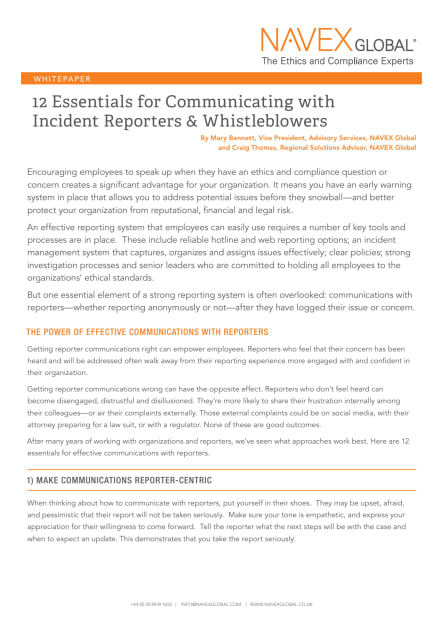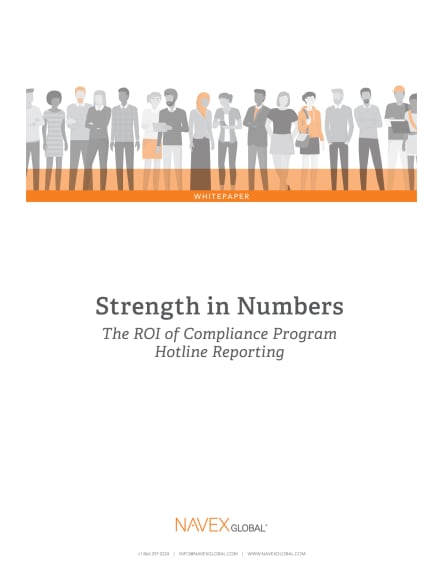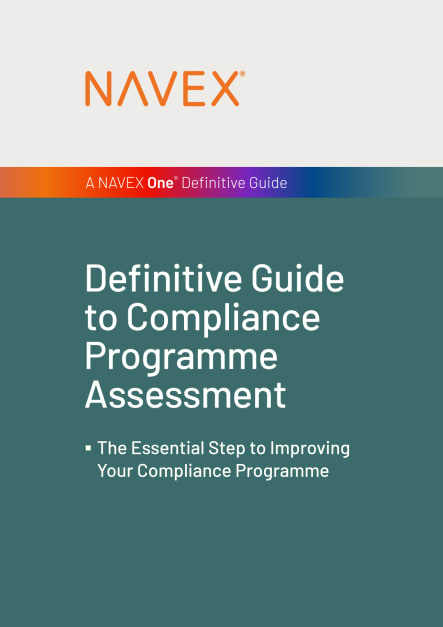About this eBooks
Maintaining a consistent message to internal reporters throughout the whistleblowing reporting process is crucial for your incident management efforts. Learn more communication tips here.
- For anyone responsible for:
- Incident management and hotline intake, capturing incident reports
- What you'll learn:
- While many tools and processes are necessary for an effective reporting system, one essential element is often overlooked: communications with reporters
- After years of working with organisations in this area, we share the twelve essentials for effective communications with incident reporters
- Page length:
- 5 pages
Read the eBooks
12 Essentials for Communicating with Incident Reporters & Whistleblowers
Encouraging employees to speak up when they have an ethics and compliance question or concern creates a significant advantage for your organisation. It means you have an early warning system in place that allows you to address potential issues before they snowball—and better protect your organisation from reputational, financial and legal risk.
An effective reporting system that employees can easily use requires a number of key tools and processes are in place. These include reliable hotline or helpline and web reporting options; an incident management system that captures, organises and assigns issues effectively; clear policies; strong investigation processes and senior leaders who are committed to holding all employees to the organisations’ ethical standards.
But one essential element of a strong reporting system is often overlooked: communications with reporters and whistleblowers—whether reporting anonymously or not—after they have logged their issue or concern.
THE POWER OF EFFECTIVE COMMUNICATIONS WITH REPORTERS
Getting reporter and whistleblower communications right can empower employees. Reporters who feel that their concern has been heard and will be addressed often walk away from their reporting experience more engaged with and confident in their organisation.
Getting reporter communications wrong can have the opposite effect. Whistleblowers who don’t feel heard can become disengaged, distrustful and disillusioned. They’re more likely to share their frustration internally among their colleagues—or air their complaints externally. Those external complaints could be on social media, with their attorney preparing for a law suit, or with a regulator. None of these are good outcomes.
After many years of working with organisations and whistleblowers, we’ve seen what approaches work best. Here are 12 essentials for effective communications with reporters.
1) MAKE COMMUNICATIONS REPORTER-CENTRIC
When thinking about how to communicate with reporters, put yourself in their shoes. They may be upset, afraid, and pessimistic that their report will not be taken seriously. Make sure your tone is empathetic, and express your appreciation for their willingness to come forward. Tell the reporter or whistleblower what the next steps will be with the case and when to expect an update. This demonstrates that you take the report seriously
2) PROTECT CONFIDENTIALITY
Every named reporter trusts that their identity will be held in confidence during the reporting and investigation process. That means a reporter’s name will only be shared with those who need to know.
All parties involved in handling a report should understand this confidentiality requirement, but leaks do occur. The most common source of a leak is the reporter himself. It is critical to inform everyone involved in a report, including the reporter, that names and details of the matter must be kept strictly confidential. To break this confidence can seriously damage the effectiveness of the reporting and investigation.
3) PROVIDE REGULAR UPDATES
Reporters who are left wondering what is happening with a report—or whether anything is happening—are in a very difficult spot. The anxiety of not knowing can nag a reporter incessantly and employers should take steps to minimise it.
A good rule of thumb is to communicate with reporting employees every one to two weeks. Incident management software, like NAVEX’s EthicsPoint Incident Management system, includes a built-in “reminder” feature—task management functionality that helps ensure investigators never miss a follow up deadline.
4) MAKE SURE ANONYMOUS REPORTERS UNDERSTAND THE NEED TO FOLLOW UP
Anonymous reporters need to understand their responsibility to follow-up on their initial report, especially during the first week—and what’s at stake if they don’t follow through. If investigators need more information to move forward with an inquiry and can’t get it, everyone loses.
You can help establish this expectation for follow-up long before someone reports by making it part of your E&C training and awareness efforts. However, this directive also needs to be built into all anonymous reporting channels through messaging in the reporting interface itself.
5) PROVIDE INVESTIGATOR/CASE MANAGER CONTACT INFORMATION
Whether or not a reporter chooses to remain anonymous, many organisations provide the name and contact information of the investigator and/or the case manager assigned to the case. This information provides a personal touch and helps reassure reporters that someone is accountable for the investigation and managing the case process.
6) MAKE SURE TEAM INTERACTIONS WITH REPORTERS ARE TIGHTLY COORDINATED
Work to ensure consistency across all teams who might interact with whistleblowers—including involved management, E&C, legal and HR. Poor coordination can give reporters mixed messages or conflicting information, and can undermine or derail the investigations process—and erode whistleblower trust. In addition, it’s essential to make sure that investigators are living up to the deadlines and expectations they’ve committed to.
7) CONSIDER USING (SOME) STANDARDISED MESSAGING FOR WHISTLEBLOWER COMMUNICATIONS
While they can feel a bit less personal, standardized reporter communications can save valuable investigator time—and guarantee that all reporter communications align with your messaging.
Organisations that take this approach typically create messages that cover the most common scenarios (response to initial report, notification that investigation is underway, notification that investigation has closed, etc.). Another upside to standardized messages is that you can make sure they adhere to your policies and messaging.
8) BE CLEAR ABOUT WHAT CAN AND CANNOT BE SHARED WITH WHISTLEBLOWERS
Your legal department (or other leadership) may have specific rules regarding what information can and cannot be shared regarding the investigation—including disciplinary action taken. Whatever your organisation decides, make sure your investigators and case managers are aware of the rules regarding reporter follow-up. Organisations should establish a consistent standard regarding what information they share.
9) PROVIDE INSTRUCTIONS FOR FURTHER FOLLOW-UP AND REPORTING AFTER CASE CLOSURE
Whistleblowers should receive notification when an investigation is complete, along with any information you can provide about the resolution. But they also need instructions about what to do if they have additional questions, believe their concern was not addressed or feel they have experienced retaliation.
While a whistleblower may be unhappy about the outcome of an investigation, it’s important to make it clear that you are still willing to listen and retaliation is reported, take prompt action to address the behavior. This support will reinforce your organisation’s commitment to creating a strong organisational culture.
10) DOCUMENT ALL WHISTLEBLOWER-RELATED INTERACTIONS IN A CENTRALISED INCIDENT MANAGEMENT SYSTEM
Centralising all information—from the initial incident report to the final communication with the reporter—has a multitude of benefits. From a whistleblower’s perspective, working within an incident management system provides a more structured and predictable experience.
From the company’s perspective, it provides a defensible audit trail should there be any question about how the case was investigated and resolved. It is also an essential interface to enable communications with anonymous reporters.
11) PREVENT AND HANDLE RETALIATION
Fear of retaliation is the number one reason employees don’t report compliance concerns. Managers need to understand and avoid behaviors that may be perceived by whistelblowers as retaliatory—for instance, not saying hello, excluding them from meetings, assigning a disproportionate amount of undesirable work, etc.
Also, monitor your work group for retaliation against an employee whom you know reported an issue and may be at high risk for reprisal. Best practice is to check in with the employee monthly for one to three months, then taper to quarterly check-ins for up to one year. If a manager detects retaliation, swift action should be taken.
12) REINFORCE YOUR CORE E&C PROGRAMME MESSAGES
Communication with reporters offers a great opportunity to emphasise key compliance messages and to further promote your organisation’s commitment to ethics and compliance. Including key phrases and terminology from compliance messaging in your whistelblower follow-up shows your organisation has a united mission.
For example, communications should emphasise that they did the right thing by speaking up and acknowledge their action helps maintain a culture of integrity at your organisation, while reinforcing the message that your organisation does not tolerate retaliation.
Conclusion
Taking the time to implement these steps shows your organisation cares about capturing—and managing—both anonymous and named reports from your employees.
Organisations with a healthy volume of compliance questions and issue reporting will reap the rewards through more engaged whistleblowers, better investigation outcomes and a stronger ethics and compliance culture.
ABOUT THE AUTHORS
Mary Bennett, Vice President, Advisory Services, NAVEX
Mary Bennett, R.Ph. is vice president of Advisory Services and a pharmacist by training. She previously served as vice president in the Compliance and Integrity office at Caremark, where she implemented the requirements of one of the first government agreements in healthcare. Mary works across all industries for the advisory services team, creating and facilitating award-winning training programs, conducting large and small program assessments, developing compliance communications and helping clients develop best practice programs from the ground up.
Craig Thomas, Regional Solutions Advisor, NAVEX
Craig works with organisations to provide best practices for their ethics and compliance programmes and ensure they get the most out of their NAVEX solutions. He was also the founding Chair of NAVEX Outreach, the organisation’s corporate social responsibility committee. He holds an MBA from Willamette University.
About NAVEX
NAVEX’s GRC software and compliance management solutions support the integrated risk, ESG and compliance management programs at more than 13,000 organizations worldwide.


